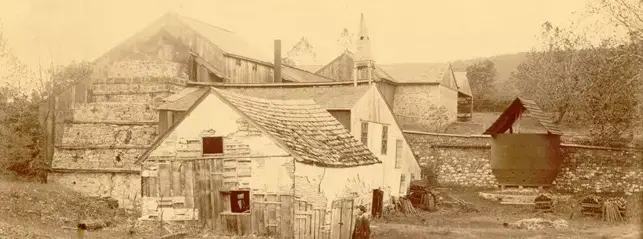History of Hopewell Furnace
It all began in the year of 1770, when 30 year-old Mark Bird, son of a successful iron-master, bought several large tracts of land in Southeastern Pennsylvania located in Berks and Chester counties. He established what is referred to as an “Iron Making Community” which consisted of entire villages that sprung up in proximity to the resources needed for the Iron making industry: iron ore near the surface, a dependable water supply, extensive hardwood forests, and limestone. Pennsylvania is abundant in these resources and by the mid-18th century it had become the leading iron-producing colony in British America.
By 1763, Bird owned more than 8,000 acres and in 1770 was declared one of the largest landowners in Berks County. According to the cornerstone, Hopewell Furnace was built in 1771, and in full operation by the following year. The first 13 years of operation remain a mystery since only records back to 1784 have survived through time. Like other Ironmasters, Bird resented the British Iron Act of 1750, which limited the production of the American Iron Industry. He was a member of the Pennsylvania Committee of Correspondence and the Pennsylvania Provincial Conference; both were radical groups which were active in the movement for independence.
After the Declaration of Independence, Bird became one of the leading patriots of eastern Pennsylvania and an example of the prominent and wealthy Americans during the revolutionary movement. After George Washington’s defeat at the battle of Brandywine, September 1777, Bird marched his men to the relief of the Continental Army. During the hard winter of 1778, he shipped a thousand barrels of flour to Washington’s troops at Valley Forge. It is also known that he supplied cannon and shot throughout the war.
Along with many other ironmasters Bird had over expanded his business during the war and was hit hard when the national economy failed. Floods and fire damaged his works at Hopewell and eventually had to put his properties up for sale in 1786. Unfortunately there were no buyers, so two years later “Hopewell Plantation” was auctioned off to James Old and Cadwallader Morris, while Bird fled creditors to North Carolina, a well-known debtor’s refuge. The furnace passed through several owners but was not profitable. James Wilson purchased the furnace in 1794 to supply his numerous forges with pig iron. Two years later the Hopewell property was again up for sale, whilst Wilson took the same route as previous owner and fled to North Carolina.
In 1800 family partners Daniel Buckley, Matthew Brooke, and Thomas Brooke took ownership of the furnace and operated it for the next 83 years. The furnaces’ records after 1800 indicate that after the purchase there were major repairs all over the Furnace property. In 1807 a series of disasters struck Hopewell causing the owners to constantly lose money in repairs. In 1808 the Buckley-Brooke partnership closed down the furnace and did not put it back into blast until 1816, when the war was over. During this time American industrial development lagged behind that of Western Europe. It ceased operation in 1817, most likely due to new methods that had reduced the amount of iron in the slag. Later in that same year it re-opened and its major productive activity now became the ever-famous Hopewell stove plate. Stove plates remained Hopewell’s most lucrative product from 1825-1844.
The improvement of the turnpikes, the construction of the Schuylkill and Union Canals, and the completion of the Reading Railroad all helped connect Hopewell to its markets. Hopewell’s transport costs were inflated by turnpike and bridge tolls on these newly constructed roads. The opening of the Schuylkill Canal in 1825 gave Hopewell a cheaper way of distribution, but at the same time altered the pattern of distribution. By 1842 all of Hopewell’s stoves were shipped by railway which costs slightly more but was much more efficient and faster too. In 1844, probably due to the decline in demand and increased costs, Clement Brooke ended large-scale stove-plate casting. During its last four decades Hopewell mainly produced pig iron, for which the demand was growing in our rapidly industrializing society.
Hopewell remained prosperous but it never again reached the peak of highest success in the years of 1825-44. In 1848, at the age of 64, Brooke retired as the ironmaster and moved into neighboring Pottstown. Hopewell went through various stages until its final blast in 1883. The property remained productive through selling wood, quarrying stone, and also farming. When the Federal Government bought the property from Mrs. Louise Brooke, in 1935, descendants of workers still lived in the tenant houses.

The Friends of Hopewell Furnace National Historic Site

Version 4 Uploaded 2024 Jan 4 Archived Documents
Version 3 Uploaded 2023 Nov 3 Appearance Improvments
Version 3 Uploaded 2023 Nov 3 Appearance Improvments
Taken 1887
New
If there is an interest in reviewing Hopewell Furnace's Archived Documents
Click on this link to the PDF document to access these archived documents.
If there is an interest in reviewing Hopewell Furnace's Archived Documents
Click on this link to the PDF document to access these archived documents.















